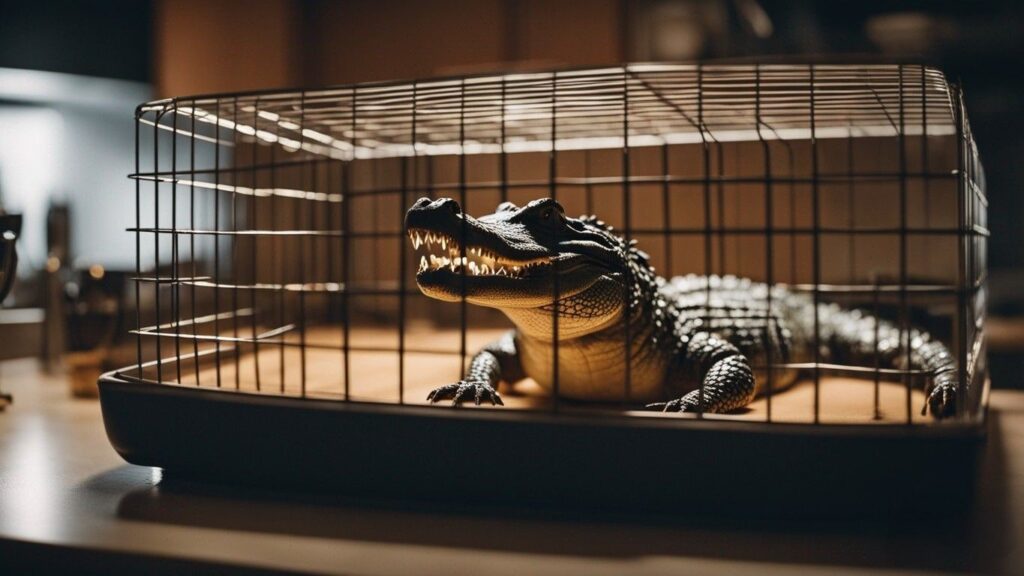
Have you ever wondered if your pet lizard recognizes you? You spend hours feeding, caring for, and interacting with your scaly friend, but do they truly recognize you as their owner?
Many lizard owners are curious about the level of awareness and bond their reptiles have with them.
In this article, we will explore the fascinating question of whether pet lizards are capable of recognizing their owners and the factors that contribute to their ability to form human-animal bonds.
So, let’s delve into the intriguing world of pet lizard cognition and find out if your scaly companion truly knows who you are.
The Nature of Pet Lizards
Pet lizards have gained popularity as household pets, captivating reptile enthusiasts with their unique beauty and intriguing behavior.
These cold-blooded creatures come from various species, each possessing its own set of characteristics and care requirements.
From small geckos to larger iguanas, pet lizards offer a diverse range of options for reptile lovers.
Understanding their behavior, cognitive abilities, and the factors that influence their recognition of familiar individuals can help foster a stronger bond between lizards and their owners.
Species of Pet Lizards
There are numerous species of pet lizards commonly kept in captivity. Some popular species include bearded dragons, leopard geckos, anoles, chameleons, and green iguanas.
Each species has its own unique set of needs and behaviors, which should be taken into consideration when selecting a pet lizard.
Researching the specific requirements of a chosen species can greatly enhance the overall experience of owning a pet lizard and contribute to their well-being.
Lizard Behavior and Social Interaction
While many people may perceive lizards as solitary and detached creatures, they do have the capability to engage in social interactions.
Pet lizards, if provided with the proper stimulation and socialization, can exhibit behaviors that suggest an awareness of their surroundings and the ability to form social bonds.
Observing their interactions within their habitat and with their owners can provide valuable insights into their cognitive abilities and recognition of familiar individuals.
Cognitive Abilities in Pet Lizards
Contrary to popular belief, pet lizards are not devoid of cognitive abilities. They possess the capacity to learn, remember, and recognize their owners.
Their cognitive skills can be seen through their recognition of familiar faces, response to distinctive smells and phrases, and the ability to associate auditory and visual cues with positive experiences.
These cognitive abilities play a crucial role in the development of a bond between lizards and their owners.
Recognition of Familiar Individuals
Pet lizards are capable of recognizing familiar individuals through various means.
While they may not comprehend the concept of owner or family in the same way humans do, they can distinguish between different people based on visual, olfactory, and auditory cues.
The Ability to Recognize Faces
Lizards can recognize the faces of their owners through visual cues. They rely on their acute vision and pattern recognition abilities to distinguish familiar faces from unfamiliar ones.
Research suggests that they may exhibit preferences for certain individuals based on their level of exposure and positive interactions.
This ability to recognize faces enables lizards to form a sense of familiarity and comfort around their owners.
Distinctive Smells and Phrases
Apart from visual recognition, lizards also possess a keen sense of smell that aids in recognition. Lizards have a specialized sensory organ called the vomeronasal organ, which is predominantly responsible for detecting pheromones and scents.
Consistently using distinctive smells, such as specific perfumes or scented lotions, can help lizards associate certain scents with their owners. Additionally, lizards may also respond to familiar phrases or names, indicating the presence of auditory recognition.
Responding to Visual and Auditory Cues
Lizards have been observed responding to their owners’ visual and auditory cues. They may exhibit changes in behavior or display signs of recognition when they see their owners or hear familiar voices. This responsiveness suggests that lizards are capable of associating specific visual and auditory cues with positive experiences, reinforcing their ability to recognize their owners.
Factors Affecting Recognition
Several factors can influence a lizard’s recognition of its owner. These factors include the amount of time spent with the owner, consistency and routine in interactions, and the use of positive reinforcement.
Time Spent with the Owner
The more time lizards spend with their owners, the more likely they are to recognize and form a bond with them. Regular and consistent interaction allows lizards to become familiar with their owners’ presence, increasing the chances of recognition. Spending quality time together can foster trust and familiarity, leading to a stronger bond between the lizard and its owner.
Consistency and Routine
Establishing a regular routine with a pet lizard helps create a sense of predictability and familiarity. Consistent feeding times, handling practices, and interaction patterns can reinforce recognition and trust. Lizards, like many other animals, thrive in environments that provide them with a stable routine. By adhering to a consistent schedule, owners can promote a sense of security and recognition in their pet lizards.
Positive Reinforcement
Positive reinforcement plays a crucial role in reinforcing recognition and strengthening the bond between a lizard and its owner. Offer rewards, such as favorite treats or gentle praise, during interactions to associate positive experiences with the owner’s presence. This positive association helps the lizard feel more comfortable and recognized in the owner’s presence.
Forming an Emotional Bond
Building a strong emotional bond with a pet lizard requires intentional efforts from the owner. Lizard-owner interactions, positive experiences and rewards, and physical contact all contribute to the formation of this bond.
Lizard-Owner Interactions
Engaging in regular interactions with a pet lizard is essential for forming a strong emotional bond. This can include activities such as handling, gentle petting, playtime, and even allowing the lizard to explore outside its enclosure under supervision. Encourage natural behaviors and cater to their specific needs, ensuring that the interactions are positive and stress-free.
Positive Experiences and Rewards
Creating positive experiences and providing rewards can greatly enhance the bond between a lizard and its owner. Offering favorite treats, engaging in enjoyable activities, and ensuring a comfortable habitat can contribute to positive associations and reinforce the lizard’s recognition of the owner as a source of happiness and fulfillment.
Physical Contact and Tactile Sensations
Physical contact plays a significant role in forming an emotional bond with a pet lizard. Gentle touching and handling can generate feelings of security and trust. Observe the lizard’s body language to ensure they are comfortable and receptive to physical contact. Establishing a mutual understanding and respect for each other’s boundaries is crucial for building a strong emotional connection.
Learning and Conditioning
Lizards, like other animals, are capable of learning and conditioning. Understanding different forms of conditioning, particularly classical and operant conditioning, can aid in establishing a positive and trusting relationship between owners and their pet lizards.
Classical Conditioning
Classical conditioning involves pairing a neutral stimulus with a positive or negative reinforcement to elicit a response. For example, pairing a specific sound, such as the jingling of keys, with the delivery of a tasty treat can associate the sound with a positive experience. Over time, the lizard may begin to associate the sound with the anticipation of a reward, leading to a conditioned response.
Operant Conditioning
Operant conditioning involves using rewards and punishments to encourage or discourage specific behaviors. Through consistent positive reinforcement, owners can train their pet lizards to associate certain actions with rewards, fostering recognition and reinforcing the bond between the lizard and the owner.
Pavlovian Theory in Lizard-Owner Relationships
The famous Pavlovian theory, known for its experiments on classical conditioning using dogs, can be applied to lizard-owner relationships. By consistently associating positive experiences, rewards, and familiarity with the presence of the owner, lizards can develop conditioned responses and exhibit recognition towards their owners.
The Role of Scent and Sound
Scent and sound play integral roles in the recognition of owners by pet lizards. By understanding the power of scent recognition and the lizard’s familiarity with the owner’s voice, owners can further strengthen the bond they share with their lizards.
The Power of Scent Recognition
Lizards have a remarkable sense of smell and can recognize familiar scents. By maintaining a consistent personal scent, such as using the same soap or lotion, owners can establish a recognizable identity that lizards associate with positive experiences. Lizards may also mark their territory with scents, allowing them to identify their own space and recognize the presence of their owner within that territory.
Familiarity with the Owner’s Voice
Lizards can distinguish between different voices and may display recognition or reactions to their owner’s voice. Talking or singing to a pet lizard in a gentle and soothing tone can help them associate the owner’s voice with calm and positive experiences. Consistently using a specific tone or phrase when communicating with the lizard can further strengthen recognition and the emotional bond between the owner and the pet.
Associating Sounds with Positive Experiences
Similar to scent recognition, lizards can also associate specific sounds with positive experiences. By pairing certain sounds, such as the opening of the enclosure or the rustling of food packaging, with rewards or pleasant experiences, owners can establish conditioned responses. This association of sounds with positive outcomes reinforces recognition and strengthens the bond between the lizard and its owner.
Evidence from Research
Experimental studies on lizard recognition, neurological findings, and comparisons with other reptilian species provide valuable insights into the cognitive abilities and recognition capabilities of pet lizards.
Experimental Studies on Lizard Recognition
Research conducted on various lizard species has shed light on their ability to recognize familiar individuals. Studies using visual, olfactory, and auditory recognition tests have shown that lizards can distinguish between familiar and unfamiliar individuals, suggesting a degree of cognitive ability in recognizing their owners.
Neurological Findings in Lizards
Neurological studies have revealed interesting findings related to the brain structures responsible for recognition in lizards. These studies indicate that parts of the lizard brain associated with olfaction and visual processing play significant roles in their ability to recognize familiar individuals. This reinforces the idea that lizards possess the neurological capacity to recognize and remember their owners.
Comparisons with Other Reptilian Species
Comparisons between different reptilian species, including lizards, have provided valuable insights into their recognition abilities. Research on turtles, tortoises, and other reptiles has revealed similar patterns of recognition and cognitive abilities, suggesting that recognition of familiar individuals may be a common trait among reptiles.
Understanding Lizard Body Language
To better understand a pet lizard’s recognition and communication, owners should become familiar with their body language. Paying attention to behavioral cues, postures, tail movements, eye movements, and pupil dilation can help interpret their feelings and degree of recognition.
Behavioral Cues and Communication
Lizards exhibit various behavioral cues to communicate their emotions and intentions. These cues can include changes in body coloration, movement patterns, observed feeding behavior, or aggression displays. By observing and understanding these cues, owners can better recognize and interpret their lizard’s emotional state, leading to a stronger bond.
Postures and Tail Movements
Postures and tail movements are significant indicators of a lizard’s mood and recognition. Positive recognition can be observed through relaxed body postures, extended limbs, and tails held high. Conversely, defensive or fearful recognition can be seen through defensive postures, retreating movements, or tail thrashing. Recognizing and responding appropriately to these cues can foster a sense of trust and understanding.
Eye Movements and Pupil Dilation
Lizards’ eye movements and pupil dilation can also provide valuable insights into their recognition and emotional state. Dilated or constricted pupils can indicate arousal or relaxation, respectively. Eye contact can convey recognition and trust, while averting eye contact may be a sign of fear or discomfort. Recognizing and respecting these signals can deepen the bond between the lizard and its owner.
Building Trust and Bonding
Building trust and bonding with a pet lizard is an ongoing process that requires time, effort, and an understanding of the animal’s needs and preferences. Taking time to establish trust, creating a comfortable habitat, and maintaining mutual respect are key elements in forming a strong bond.
Taking Time to Establish Trust
Establishing trust with a pet lizard is crucial for building a strong bond. Provide ample time and space for the lizard to acclimate to its new environment and gradually introduce interactions. Avoid rushing the process and prioritize the lizard’s comfort and safety. Patience and respecting the lizard’s boundaries will help strengthen trust and recognition.
Creating a Comfortable Habitat
A comfortable and stimulating habitat is essential for a lizard’s well-being and bond formation. Ensure the enclosure is appropriately sized, well-designed, and furnished with appropriate hiding spots, basking areas, and environmental enrichment. Maintaining optimal temperature and humidity levels, as well as providing a varied diet, are also essential factors in creating a comfortable habitat that promotes recognition and positive interaction.
Mutual Respect and Patience
Establishing a bond with a pet lizard requires mutual respect and patience. Respect the lizard’s natural behaviors and stress signals, and avoid forcing interactions or handling when the lizard is not receptive. Develop a bond based on understanding and cooperation rather than dominance. Consistently providing positive experiences, rewards, and maintaining a stress-free environment will contribute to a thriving bond.
The Reciprocal Relationship
It is important to acknowledge that the bond between a lizard and its owner is not one-sided. Pet lizards can also recognize and respond to their owners, establishing a reciprocal relationship that goes beyond basic recognition.
Owner Recognition by the Pet Lizard
Pet lizards can recognize their owners and display recognition through various behaviors and responses. They may exhibit signs of excitement, approach the owner, or exhibit behavioral changes specific to their owner’s presence. This reciprocal recognition strengthens the bond between the lizard and the owner, fostering a deeper and more meaningful relationship.
The Human Role in Building Trust
Owners play a vital role in building trust and recognition in their pet lizards. By providing a safe and stimulating environment, regular interaction, positive reinforcement, and consistent care, owners can foster recognition and ensure the lizard feels secure and comfortable. Taking the time to learn about their specific species and individual needs also demonstrates the owner’s commitment to the lizard’s well-being and strengthens the bond between them.
Maintaining a Strong Bond
Maintaining a strong and healthy bond with a pet lizard requires ongoing effort and attentiveness. Regular interaction, continued positive reinforcement, and observance of the lizard’s behavior and needs are essential. Adapting to changes in the lizard’s preferences or habits demonstrates the owner’s dedication and commitment to the relationship. By consistently nurturing the bond, owners can ensure a lasting and meaningful connection with their pet lizards.
Final Thoughts
In conclusion, pet lizards are capable of recognizing their owners through a combination of visual, olfactory, and auditory cues.
Factors such as time spent with the owner, consistency and routine, and positive reinforcement significantly influence a lizard’s recognition capability.
Lizards possess cognitive abilities that enable them to bond emotionally with their owners, respond to conditioned stimuli, and exhibit recognition through body language and behavioral cues.
By understanding and respecting their lizard’s needs, body language, and preferences, owners can build a strong, reciprocal, and lasting bond with their pet lizards.



